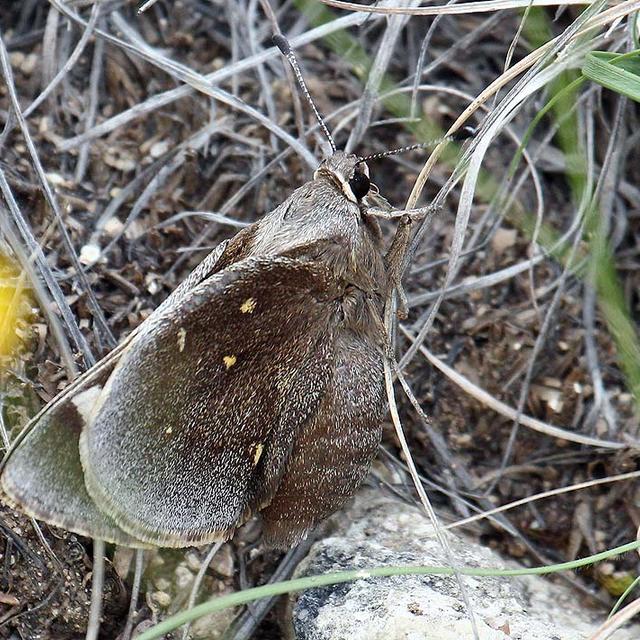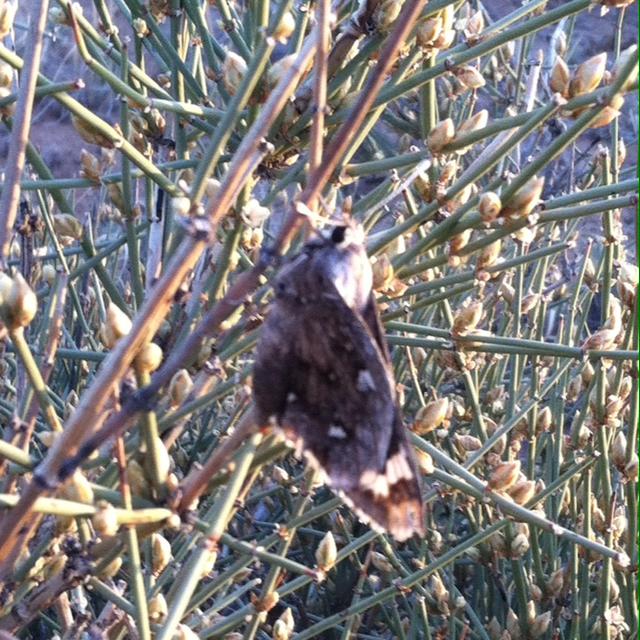Strecker's Giant-Skipper
Megathymus streckeri (Skinner, 1895)
Family: Hesperiidae
Subfamily: Hesperiinae
Tribe: Megathymini
Identification: Forewings are wide. Upperside is black; forewing has white spots near the tip and a yellow band; hindwing has a white to yellow marginal band and long hairlike scales. Underside of hindwing is gray or mottled gray and black, and has few to several white spots.
Wing Span: 2 1/4 - 3 1/16 inches (5.7 - 7.8 cm).
Life History: Females make clicking noises during flight. Adults bask on old yucca stalks with their hindwings spread; the uppersides resemble old seedpods. To await receptive females, males perch and sometimes patrol all day around the host plants. Females glue eggs singly on leaves of the host plant. A young caterpillar burrows into the stem to the root without making a tent. After hibernating in the burrow, the caterpillar surfaces through the stem or soil and constructs a tent of silk, soil, and plant debris in which to pupate. Chrysalids can move about in their tent.
Flight: One brood from May-July.
Caterpillar Hosts: Small soapweed (Yucca glauca), Buckley yucca (Y. constricta), fineleaf yucca (Y. angustissima), and Bailey's yucca (Y. baileyi).
Adult Food: Adults do not feed, but males sip moisture from mud.
Habitat: Sand hills, rocky bluffs, short-grass prairie, shrubland, open woodland.
Range: Southeastern Montana and southwestern North Dakota south to South Texas, west to northwestern Arizona and southwestern Utah.
Conservation: Not usually required.
NCGR: G4 - Apparently secure globally, though it might be quite rare in parts of its range, especially at the periphery.
Management Needs:
Please donate!
We depend on donations to keep Butterflies and Moths of North America freely available. We want to express our gratitude to all who showed their support by making a contribution this year. You can donate to support this project at any time.
Advertise with us!
Do you have a product or service that you think would interest BAMONA users? If you would like to advertise on this website, contact us by email, or use the contact form and select the "Advertising" category.
Verified Sightings
Displaying 1 - 24 of 169 verified sightings

Observation date: Apr 03, 2025
Submitted by: tonzetich
Region: Bexar County, Texas, United States
Verified by: jwileyrains
Verified date: Apr 04, 2025

Observation date: May 28, 2024
Submitted by: Joshua C
Region: Harding County, New Mexico, United States
Verified by: stevecary
Verified date: Sep 04, 2024

Observation date: May 14, 2024
Submitted by: Joshua C
Region: San Juan County, New Mexico, United States
Verified by: stevecary
Verified date: Aug 11, 2024

Observation date: Jun 12, 2024
Submitted by: twofried
Region: Taos County, New Mexico, United States
Verified by: stevecary
Verified date: Jun 14, 2024

Observation date: Jun 06, 2024
Submitted by: DeepSkyKelly
Region: Union County, New Mexico, United States
Verified by: stevecary
Verified date: Jun 06, 2024

Observation date: Mar 27, 2023
Submitted by: pattypasztor
Region: Texas, Kendall County, United States
Verified by: jwileyrains
Verified date: Mar 29, 2023

Observation date: Jun 17, 2022
Submitted by: stevecary
Region: Union County, New Mexico, United States
Verified by: stevecary
Verified date: Dec 30, 2022

Observation date: Jun 08, 2021
Submitted by: g l warrick
Region: Cherry County, Nebraska, United States
Verified by: J_Martineau
Verified date: Jun 09, 2021

Observation date: Apr 21, 2015
Submitted by: Martin Reid
Region: Blanco County, Texas, United States
Verified by: stomlins701
Verified date: Nov 16, 2019

Observation date: Jun 08, 2019
Submitted by: Christian.Nunes
Region: Las Animas County, Colorado, United States
Verified by: mikefisher
Verified date: Sep 21, 2019

Observation date: Jun 06, 2019
Submitted by: Christian.Nunes
Region: Las Animas County, Colorado, United States
Verified by: mikefisher
Verified date: Sep 21, 2019

Observation date: Jun 14, 2019
Submitted by: joeschelling
Region: Harding County, New Mexico, United States
Verified by: stevecary
Verified date: Jun 21, 2019

Observation date: May 29, 2017
Submitted by: bernardrfoy
Region: Santa Fe County, New Mexico, United States
Verified by: stevecary
Verified date: Sep 09, 2017

Observation date: Jun 05, 2016
Submitted by: joeschelling
Region: Union County, New Mexico, United States
Verified by: stevecary
Verified date: Jul 01, 2016

Observation date: May 14, 2016
Submitted by: Amy Helen Chu
Region: Las Animas County, Colorado, United States
Verified by: mikefisher
Verified date: May 22, 2016

Observation date: May 10, 2014
Submitted by: joeschelling
Region: Sandoval County, New Mexico, United States
Verified by: stevecary
Verified date: May 26, 2014

Observation date: Apr 30, 2013
Submitted by: Jeff Trahan
Region: Natchitoches Parish, Louisiana, United States
Verified by: stomlins701
Verified date: Apr 30, 2013

Observation date: Jun 04, 2005
Submitted by: stevecary (Mike Stake)
Region: Taos County, New Mexico, United States
Verified by: stevecary
Verified date: Jan 14, 2011
Observation date: Jun 25, 1967
Submitted by: legacy.reporter (Kilian Roever)
Region: Coconino County, Arizona, United States
Verified by: Ken Davenport (Ken Davenport)
Verified date: Jan 01, 2011
Observation date: May 29, 1966
Submitted by: legacy.reporter (Kilian Roever)
Region: Navajo County, Arizona, United States
Verified by: Ken Davenport (Ken Davenport)
Verified date: Jan 01, 2011
Observation date: May 26, 1967
Submitted by: legacy.reporter (Kilian Roever)
Region: Navajo County, Arizona, United States
Verified by: Ken Davenport (Ken Davenport)
Verified date: Jan 01, 2011
Observation date: May 25, 1949
Submitted by: legacy.reporter (Stallings & Turner)
Region: Navajo County, Arizona, United States
Verified by: Ken Davenport (Ken Davenport)
Verified date: Jan 01, 2011
Observation date: May 30, 1966
Submitted by: legacy.reporter (Kilian Roever)
Region: Navajo County, Arizona, United States
Verified by: Ken Davenport (Ken Davenport)
Verified date: Jan 01, 2011
Observation date: May 26, 1967
Submitted by: legacy.reporter (Kilian Roever)
Region: Navajo County, Arizona, United States
Verified by: Ken Davenport (Ken Davenport)
Verified date: Jan 01, 2011
- 1 of 8
- next ›


